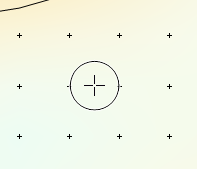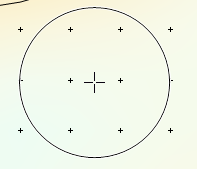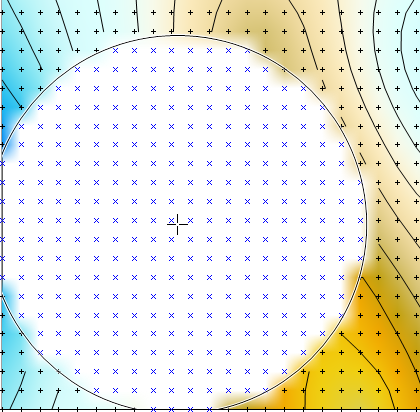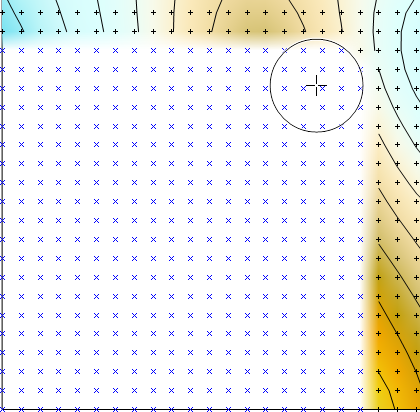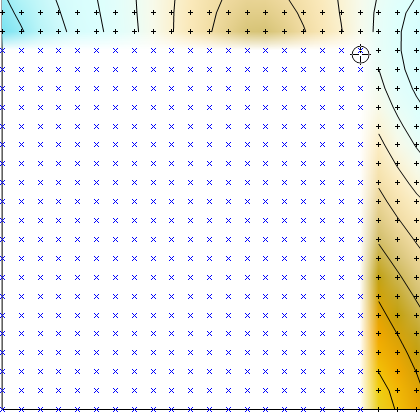The Grid Editor | Tools | Eraser command in the grid editor assigns the NoData value (1.70141e+038) to the grid nodes within the brush. Click the Grid Editor | Tools | Eraser command or the  button to start eraser mode. The cursor changes to a crosshair with a circle to visually indicate the eraser Brush size
button to start eraser mode. The cursor changes to a crosshair with a circle to visually indicate the eraser Brush size  . The Eraser command button is highlighted in yellow to indicate eraser mode as well.
. The Eraser command button is highlighted in yellow to indicate eraser mode as well.
Press ESC or click another Grid Editor | Tools command to end Eraser mode.
Brush Size
The Brush size tool option controls the diameter of the tool. The Brush size specifies the diameter in number of grid cells in the X direction. The Brush size setting is located in the tools options bar at the top of the grid editor window. There are three methods for changing the Brush size:
- Click in the Brush size field and type the desired Brush size.
- Click the
 buttons to increment the Brush size by one. Click and hold the
buttons to increment the Brush size by one. Click and hold the  buttons to quickly scroll the Brush size value up or down.
buttons to quickly scroll the Brush size value up or down. - Press the [ key to decrease the Brush size. Press the ] key to increase the Brush size. Press and hold the [ or ] key to quickly decrease or increase the Brush size. The [ and ] keys increment the Brush size by 1 at Brush size values less than 10. The increment increases to 5 at a Brush size greater than 10 and less than 50. The increment increases to 10 at a Brush size greater than 50 and less than 100. The increment size continues to increase as the Brush size increases.
The cursor circle increases or decreases size with the Brush size setting and zoom level. The Brush size setting is saved and persistent across multiple grid editor windows.
|
|
|
|
A Brush size of 1 makes the diameter of the brush equal to the horizontal spacing of one grid cell. |
A Brush size of 3 makes the diameter of the brush equal to the horizontal spacing of three grid cells. |
Undo
Each click is registered as one operation in the Undo levels list. For example, if you set the Brush size to 1 and click once on five individual grid nodes, you must use the Undo command five times to undo all the changes. However, if you click and drag once across all five grid nodes, you must only use the Undo command once to undo all the changes.
Erasing Grid Values Example
The following example will demonstrate using the Erase command to assign the NoData value to a 20x20 node section of the Demogrid.grd sample file grid with the Erase command,
-
Click the Grid Editor | Tools | Eraser command.
-
Set the Brush size to 20 by typing 20 in the Brush size field.
-
Click once in the grid near node (9,9). This is approximately (1.6,1.6) in map coordinates. The cursor map coordinates are displayed in the status bar.
|
|
|
Many nodes can be erased in a single click when the Brush size is large. |
-
Press and hold the [ key to reduce the Brush size to 5.
-
Click and drag around the NoData region to create a rectangle.
|
|
|
Click and drag with Erase to create any shape NoData region. |
-
A Brush size of 5 is too large to easily erase the final node. Change the Brush size to 1.
-
Click the node at (19,19) in grid coordinates to create the 20x20 node NoData rectangle.
|
|
|
Erasing single nodes is easier when the brush size is small. |
